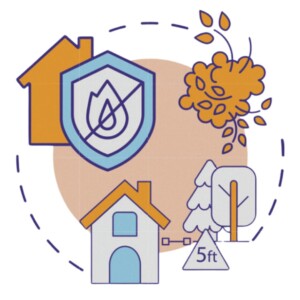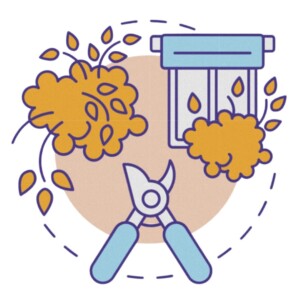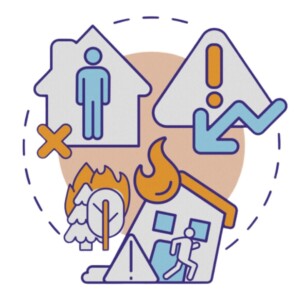Six Steps for Making Your Home More Wildfire-Resistant
Wildfires are on the rise in Hawai‘i. Here are ways to protect homes and neighborhoods.

Unlike in other parts of the United States, wildfires have not been a longtime feature within Hawai‘i’s ecosystem. But changes in land use, population and climate have escalated fire risk in the Islands, “literally in two generations,” says Andrea “Nani” Barretto. She is a co-executive director at the Hawai‘i Wildfire Management Organization, a nonprofit based in Waimea. “In terms of our behaviors and understanding, we have a lot to catch up on.”
Additionally, fighting fires can be more difficult in Hawai‘i. “It’s not only trying to get resources from the continental U.S., but even sharing resources like an engine truck from island to island,” says Michael Walker, the state’s fire protection forester at the Department of Land and Natural Resources’ Division of Forestry and Wildlife.
However, wildfires “are not like other natural hazards,” says Barretto.
“We can control where wildfires go, unlike hurricanes.” We can also predict where wildfires may travel. The majority of homes are ignited by embers that fly through the air. Piles of leaves that accumulate in certain spots in your yard or on your roof, these are good clues to where wind would spread a fire. The good news is, says Barretto, “There are a lot of proactive steps residents can take ahead of time to protect their homes, yards and neighborhoods from wildfire.”
Firefighting should be seen as the last line of defense, according to Barretto. “There’s a myth that the fire fighters can just come out and take care of it. When a wildland fire turns into a structure-to-structure fire, that is a conflagration, and they won’t be able to keep every home safe. It’s really up to the resident to keep their home and yard fire-resistant. Because wildfires are a new reality; they aren’t going anywhere.”
Here are six ways to fortify your home against wildfires.
1. Harden the First Zone
The first five feet around your home is a crucial zone, says Walker. Since homes are often ignited by ember showers, you want an area where there is nothing for embers to ignite. Envision smooth river rocks and minimal plantings, for example, rather than a bunch of bushes surrounded by tree-bark mulch. Pavers and gravel are other noncombustible options that can be used close to the structure.
2. Schedule Maintenance
Just as we have regular cleaning tasks around the interior of the home, Barretto suggests a weekly tidying of exterior areas. “You want the yard to be lean, clean and green,” she says. That means minimizing fuel sources and keeping what remains moist.
Remove weeds and debris such as dead leaves and branches from your yard, roof, carport and lānai, and clear any vegetation out from under steps and other surfaces. Mow grass to a low height. Keep gutters clean.
Prune low-hanging branches so that nothing is lower than 6 to 10 feet off the ground. “There has been some concern with people having trees in their yard. It’s fine to have trees; it’s how you maintain them,” says Walker. Lower hanging limbs, he explains, are ladder fuels that can spread flames upward.
You don’t want crispy-dry plants, so keep your yard’s irrigation system maintained and active. You can also investigate using drought-resistant plants or xeriscaping to reduce the need for watering.
3. Pick Up Clutter
“A lot of times in Hawai‘i, we have the surfboards, the one-man canoes, the lumber for the projects, and you lean them against the side of the house,” says Nicholas Tanaka. He is a public education officer and fire inspector with the Maui Fire Department’s Fire Prevention Bureau.
“Removing the fuel from the area around your house is a best defense,” says Tanaka. That includes items like propane tanks or stacked firewood.
Limit combustibles like outdoor furniture and planters in those first 5 feet around the home, suggests Barretto. Minimize the use of wood lawn furniture and swing sets and leave plenty of space between them. Table umbrellas, and accessories like shades, screens and even natural fiber doormats, can catch fire too. Select materials that are more fire-resistant, like a rubber doormat.
4. Stay Mindful of Materials
Whether constructing a new home, or renovating, building materials matter. Go for glass skylights, for example, rather than plastic or fiberglass versions that might melt if embers land on them. Choose aluminum gutters over plastic versions, and for fences, use metal rather than wood.
Window size is a factor too, according to Tanaka. “Bigger windows will break faster in heat because of thermal expansion.” Invest in good double-paned windows, he suggests.
Also, any hollow spaces, such as eaves, soffits (the connecting material beneath eaves) and vents should be covered with a 1/8-inch mesh, to repel embers.
Building a wildfire-resistant home can be done for roughly the same construction costs as a typical home, and many such homes have additional benefits such as reduced maintenance or longer lifespan, according to research conducted by Headwaters Economics, a Montana-based nonprofit research group focused on community development and land management.
Fire-resistant roofing options include composition shingle, metal, clay or cement tiles; for exterior walls, fire-resistant building materials include cement, plaster, stucco and masonry.
Retrofitting an existing home can be more costly than building new, with components such as the roof and windows adding significant expense, according to Headwaters’ research.
However, “if you are doing an upgrade to your home, that is a good opportunity to invest in wildfire safety, because you can kill two birds with one stone,” says Barretto.
Your top priority should be a fire-resistant roof, as the large surface area makes it particularly vulnerable to catching fire.
5. Be Ready To Go
“The best defense against what people are concerned about – structural ignition – is nothing you need to buy,” says Tanaka. “We want to be prepared and it can be as simple as a go bag. Have some water, a couple changes of clothes, medications and important documents in something you can easily evacuate from your house,” he says.
He adds that mental preparation and acceptance is important, too. “Be prepared to say goodbye to what you know,” he says, “and only take what you really need to have.”
6. Create Community
Walker encourages people to join a Firewise program. “It’s a nationwide program where you can get your community assessed; it’s a great way for folks to get to know each other, discover risks, and find out who is elderly or disabled, who might need help with their lawn maintenance or evacuating in an emergency. You can protect your community as a whole.”
You can, as a community, also figure out evacuation routes. Ideally, plan for at least two routes out of the neighborhood.
On Hawai‘i Island, Erin Harner is a Firewise team leader for the Pu‘u Anahulu community, a Kailua-Kona neighborhood of 150 homes. She became certified for the volunteer position in 2020.
She and her fellow volunteers typically throw one event a month, such as “chipper day,” where neighbors were asked to collect dry leaves and dead branches, and a chipper company came through and turned the waste into mulch.
Another month, they hired a big dumpster for green waste, and neighbors piled it high. “Pulpy stuff, like bananas, or agave, or trimmings from bushes,” says Harner. “We filled that dumpster up three times. People love it. You find something they need and want, and then they will participate.”
Sometimes, the assistance is more personal, like the time volunteers got together to help an elderly resident clear an overgrown vacant lot next to her home. And the volunteer fire department has assisted with training.
Harner has also received training from the Hawai‘i Wildfire Management Organization’s Wildfire Home Risk Assessor Program, which helps homeowners spot risk potential. “Nani got about 50 people to show up in Kona from four islands; we had two days of training, and then Zoom meetings afterward to continue the education,” Harner says. The free risk assessments take about 30 to 60 minutes; request one at the HWMO’s website.
“I’m telling my neighbors, who I play pickleball with, ‘Let me come do an assessment,’ ” she says.
She notes that after a large fire, there’s a lot of attention and concern about the topic, but then community interest may dwindle.
“We had a big fire behind our community a few years ago,” she says, “and people were freaking out. About 100 people came to our next meeting. The last meeting we had, there were only 20 people there.”
As Barretto notes, “There is a role for everyone in fire prevention. Fire is complex, and 99% of wildfires are started by people. It’s a human issue – a human disaster. The only way to solve it is through the e orts of humans.”









